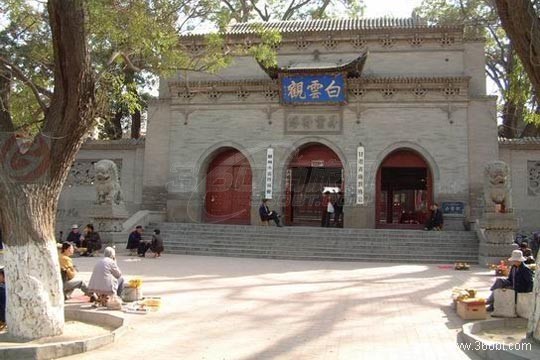
White Cloud Temple
White Cloud Temple (Baiyun Guan ), located in southwest Beijing, is one of "The Three Great Ancestral Courts" of the Complete Perfection School of Taoism, and its title is "The First Temple under Heaven." It is also the largest Daoist architectural complex in Beijing and was the former headquarters of the Dragon Gate sect.
In Chinese, Taoist temples are not actually called temples, but Guan. Guan is similar in meaning with "to look at" or "observe." This is a reflection of the Taoist belief that understanding the Tao comes from a direct observation of nature, rather than scholastic or theological studies.
White Cloud Temple was built in 739 and went through three renovations – in 1706, 1714 and 1886. The architecture seen today is mainly from the Ming (1368-1644) and Qing (1644-1911) Dynasties. The Center of the Chinese Taoist Association, founded in 1958, is also located here. The Yuan Emperor Shizu (Kublai Khan), whose reign lasted from 1260 to 1293, appointed a Daoist priest from Shandong province to the position of "National Teacher," which nominally put him in charge of all Chinese Daoist affairs. This priest's name was Qiu Chuji, who was commonly known as the Sage of Eternal Spring. While Qiu Chuji was in Beijing, he resided in the Temple of the Great Ultimate, which he expanded and renamed the Temple of Eternal Spring. From then on, it became the center of Daoism in northern China. It was not until the Zhengtong era of the Ming Dynasty that its current name was adopted.
Every year on the 19th day of the first lunar month a festival is held at the abbey in celebration of Qiu Chuji's birthday. It was once believed Qiu would return to earth as an immortal on this day. The festival was first held during the Yuan Dynasty, but was suspended after the People's Republic of China was established in 1949. The temple was revived in the 1990’s, and the festival has been held to this day.
The temple has various halls which house the gods of Taoism. The building's complex, arranged generally in a straight line, can be divided into three groups, the middle section, the east section and the west section. At the back one can find a beautiful garden.
Nowadays, the temple attracts pilgrims and tourists from all over the world. The Spring Festival Fair and its celebration is also a wonderful place to learn more about Chinese culture and tradition.
During the fair, one interesting activity is touching the stone monkey. The monkey is hidden in different places throughout the temple. It is said that the monkey is the incarnation of a god; so visitors always like to touch it for good luck. There are three stone monkeys located at different places inside. And those who are interested can spend the day searching for them. It is believed that whoever touches all three monkeys their wishes will come true.
Opening Hours: 8:30--16:00
Ticket Price: RMB10
Address: 6 Baiyunguan Jie, Xibianmenwai, Xuanwu District, Beijing
Take bus Te 6, 45, 80, Te 5, 717, 319, 26 and get off at Baiyunguan Station.
We Recommend:
